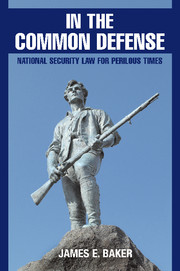Book contents
- Frontmatter
- Contents
- Acknowledgments
- Abbreviations
- Introduction
- 1 Perilous Times: Describing the Threat
- 2 The Meaning of National Security
- 3 National Security Law
- 4 Constitutional Framework
- 5 Electronic Surveillance: Constitutional Law Applied
- 6 National Security Process
- 7 Intelligence
- 8 Use of Military Force
- 9 Homeland Security
- 10 The National Security Lawyer
- Attachments
- Notes
- Index
8 - Use of Military Force
Published online by Cambridge University Press: 26 July 2009
- Frontmatter
- Contents
- Acknowledgments
- Abbreviations
- Introduction
- 1 Perilous Times: Describing the Threat
- 2 The Meaning of National Security
- 3 National Security Law
- 4 Constitutional Framework
- 5 Electronic Surveillance: Constitutional Law Applied
- 6 National Security Process
- 7 Intelligence
- 8 Use of Military Force
- 9 Homeland Security
- 10 The National Security Lawyer
- Attachments
- Notes
- Index
Summary
Cicero said laws are inoperative in war (“silent enim leges inter arma”). In fact, there is U.S. and international law that applies to the decision to use force and the manner and method in which it is used. In U.S. practice there are three contextual legal questions that should arise when the president or his advisors contemplate the use of military force. First, does the president have the constitutional authority to use force? This is a “war powers” question. Second, is the contemplated force lawful under international law? This is a question involving that portion of the law of armed conflict known as the jus ad bellum (thresholds for resorting to force). Third, are the means selected lawful? This is a question involving the jus in bello (the law applying to the means and methods of war). It may also be a question of U.S. criminal law to the extent that U.S. law implements international law, or imposes obligations independent of international law.
Few areas of law are as important to national security as is this collective body of domestic and international law. This is intuitive in situations in which force is actually used; however, in other scenarios falling short of force the implied or express threat of military intervention is itself the catalyst for policy influence. For the national security lawyer, no area of law will have the same implications in defining a world of public order and individual security.
- Type
- Chapter
- Information
- In the Common DefenseNational Security Law for Perilous Times, pp. 176 - 239Publisher: Cambridge University PressPrint publication year: 2007



